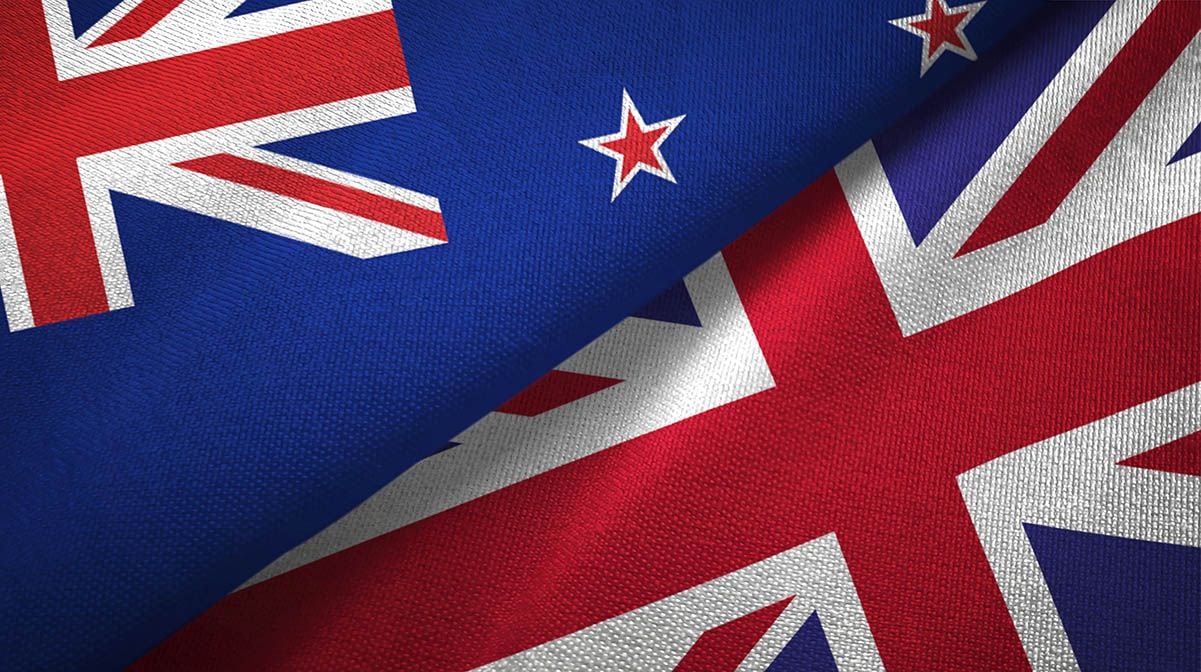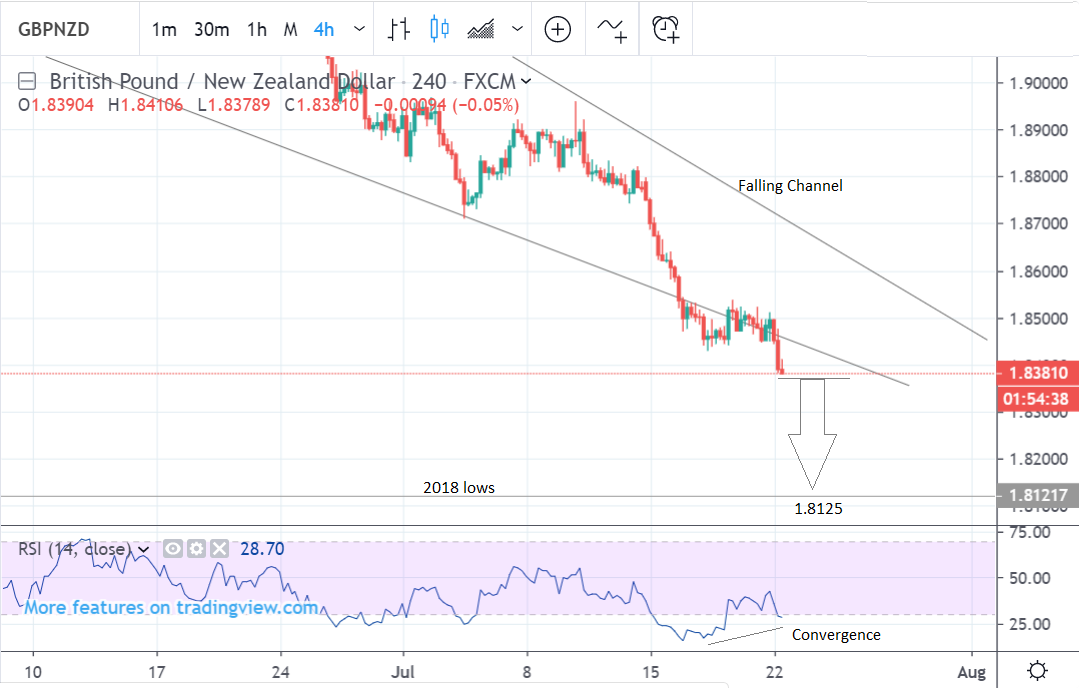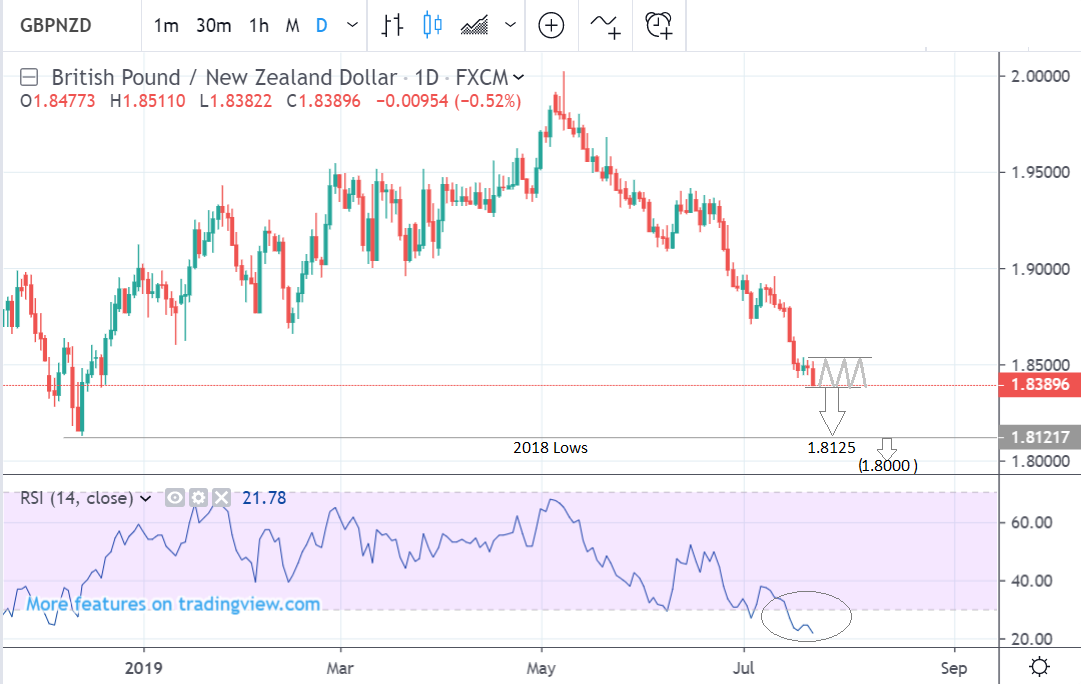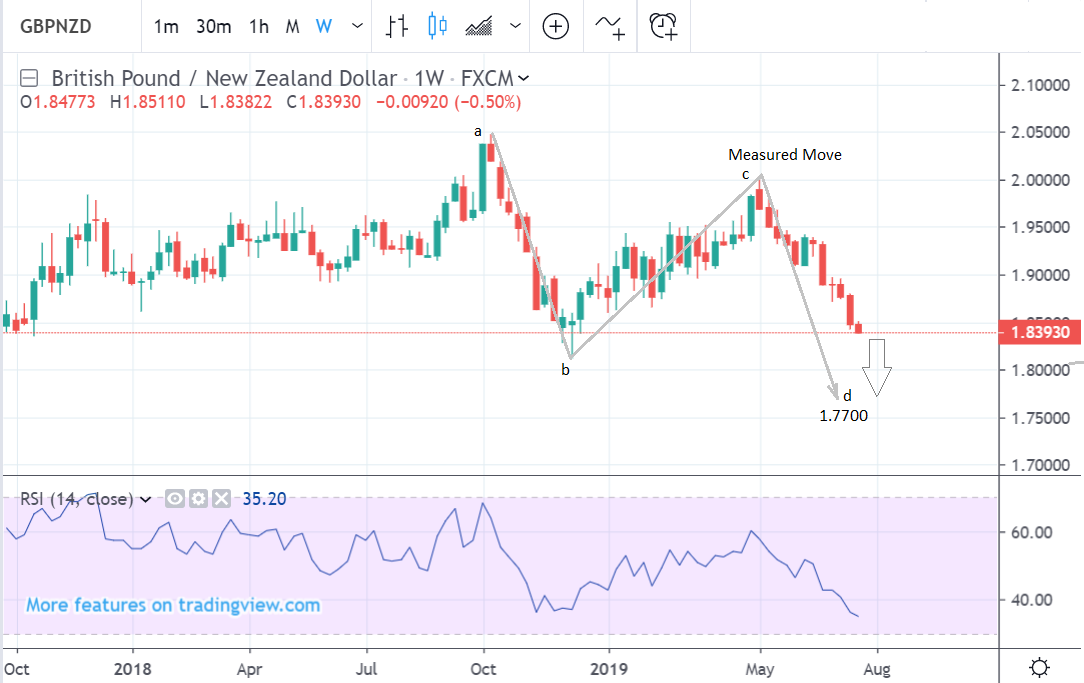The Pound-to-New-Zealand-Dollar Rate: Strong Downtrend in Play and Likely to Extend

Image © Adobe Stock
- GBP/NZD in strong downtrend that looks set to extend.
- Technicals, Brexit headlines, put new lows in sight for GBP.
- GBP eyes incoming Prime Minister as global factors drive NZD.
The Pound-to-New Zealand-Dollar rate was trading at around 1.8391 Monday after falling almost half a percent at the beginning of the new week, although studies of the charts suggest the exchange rate is likely to continue declining in the days ahead.
The 4 hour chart, which we use to determine the short-term outlook including the next 5 days, shows the pair in a steep decline and there are few signs of reversal thus far. The relative-strength-index (RSI) momentum indicator is the only fly in the ointment for bears.
On the four-hour chart the RSI is converging bullishly with price, which means when price is falling to new lows it is failing in lockstep. This suggests a risk of a pull-back is developing. However, it is not enough to suggest a reversal of the dominant downtrend.
We see the uninterrupted trend extending all the way down to the 1.8125 level, which coincides with the 2018 low, although this is subject to a confirmatory break below the 1.8370 threshold.

Above: GBP/NZD rate shown at 4-hour intervals.
The daily chart, which we use to give us an indication of the outlook over the medium-term including the next month ahead, shows the pair in a steep decline since the beginning of May. This established downtrend is expected to continue.
Again, the only slight concern here is the RSI momentum indicator in the lower pane, which is below 30 and in the oversold zone This increases the risk of a pull-back although it doesn't guarantee one.
Notwithstanding the oversold RSI, the pair will probably extend lower. A break below the 1.8370 level would confirm a continuation down to a target at 1.8125 and then below that the door would be open for a move down toward 1.8000.
There is also a chance the pair could move sideways for a time because it is oversold and might be due a pull-back.

Above: GBP/NZD rate shown at daily intervals.
The weekly chart, which we use to give us an idea of the longer-term outlook including the next few months ahead, shows pair forming a bearish measured move pattern. This is incomplete and suggests an extension of the downtrend lower to a target based on the proportions of the pattern.
The length of the final c-d leg can usually be forecast using the length of the a-b leg, and in this case it suggests an end target of around 1.7700.

Above: GBP/NZD rate shown at weekly intervals.
AA
The New Zealand Dollar: What to Watch
The New Zealand Dollar (Kiwi) is currently being driven by global risk trends which are ebbing and flowing between headwind and tailwind for the currency.
On the U.S.-China trade deal front, the situation seems to be improving after President Trump tweeted that Treasury Secretary Mnuchin had a “very good call” with his Chinese counterpart and the government-sponsored Global Times appeared to back this up with a tweet saying that face-to-face talks are not far off.
Remarks on trade talks should be taken with a healthy dose of scepticism though because they seem to change with the wind and only last week Trump was saying ‘we are a long way from a deal’ and that Chinese links to Google needed to be investigated.
Meanwhile, Mnuchin was saying the opposite - that everything was fine and a deal is around the corner. It may sound cynical but it could be Trump’s positive tweet Monday was aimed at showing solidarity to his Treasury Secretary after contradicting him so starkly last week.
The other key driver of global risk trends to which the Kiwi is sensitive is the flare-up in the Gulf between Iran and the UK, which has the potential to escalate. In the most recent turn of events, a UK tanker was seized by Iranian revolutionary guard as it passed through the Strait of Hormuz. T
The UK condemned the capture and a British frigate H.M.S Montrose approached and warned the Iranians to back-off, but it was too far away to intervene. Oil will probably be the asset most affected should tensions escalate.
If the oil price continues to rise it could spark concerns about rising fuel costs weighing on businesses and consumers, which might reduce growth and hurt the Kiwi.
The only domestic data release of any note from New Zealand is the trade balance which is forecast to show a NZ$100m surplus in June - down from NZ$264m in May. On a yearly basis, however, the balance is likely to show a deficit of NZ$5.1bn compared to NZ$5.5bn previously. A trade deficit is usually a negative factor for a currency as it means more currency has to be sold to purchase foreign imports than is bought by foreigners to purchase NZ exports.
AA
The Pound: What to Watch
The major driver of the Pound this week is likely to be the announcement of the winner of the Conservative Party leadership election on July 22, but with little difference remaining between the two candidates' stated Brexit policies, the result may not cause as much volatility as previously expected.
Jeremy Hunt is seen as more ‘moderate’ and less likely to take the UK out of the EU without a deal, so his election might provide some relief for Sterling. The opposite is true of Boris Johnson, who is the bookmakers' favourite to win, although such an outcome is likely in the price of the Pound by now.
According to betting website oddschecker, Johnson's chances of winning have increased to 97.08%. On the data front the major release is the CBI Industrial Trends survey, which on Tuesday and a speech from Bank of England’s (BOE) chief economist Andy Haldane on the same day.
Andy Haldane is set to make a speech at 13.15 on Tuesday. The market will be keen to hear his views on the economy after recent mixed data. Previously the BOE had been one of the few major central banks not expected to cut interest rates, and was actually talking about raising them. Much depends on Brexit of course. Will Haldane continue to endorse a marginally hawkish stance, or is he going to turn more neutral? On Tuesday we shall see. If he changes his tune it could weigh on Sterling.
The CBI survey is usually closely followed because it provides timely insight into changing industrial trends. Industrial production unexpectedly plunged -2.7% in June and although it rebounded 1.4% in July it was a worrying result, and the worst since 2013. Investors will therefore be keen to see what the CBI data reveals when it is released on Tuesday at 11.00 BST and whether the sector is likely to see more declines in the future or not.

Above: Changes in UK industrial production. Source: Tradingeconomics.com.
Time to move your money? Get 3-5% more currency than your bank would offer by using the services of foreign exchange specialists at RationalFX. A specialist broker can deliver you an exchange rate closer to the real market rate, thereby saving you substantial quantities of currency. Find out more here.
* Advertisement




